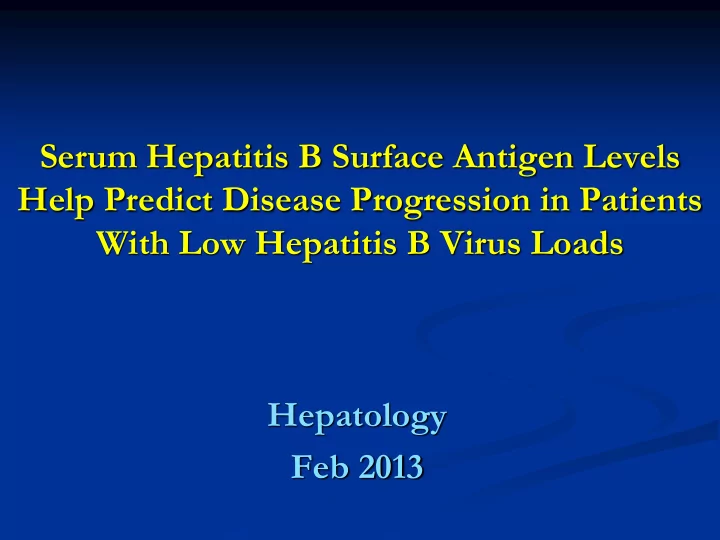

Serum Hepatitis B Surface Antigen Levels Help Predict Disease Progression in Patients With Low Hepatitis B Virus Loads Hepatology Feb 2013
Hepatitis B Surface Antigen HBsAg is the glycosylated envelope protein of the mature HBV virion.
Hepatitis B Surface Antigen HBsAg has been used as a marker for the diagnosis of HBV infection since it was first discovered by Blumberg and his colleagues in 1968.
HBsAg Quantification Recent studies have addressed the use of serum HBsAg level to stratify the risk of disease progression and predict treatment response in chronic hepatitis B.
Pathway of HBsAg Production in the Life Cycle of HBV Replication
HBsAg levels in different phases of chronic HBV infection
HBsAg levels in different phases of chronic HBV infection
HBsAg levels in different phases of chronic HBV infection
HBsAg level and HBsAg loss
HCC in Low-viremic Patients eAg – ve, HBV DNA <2000 IU/mL Gastroenterology 2012;142:1140 – 1149
PEG-IFN in HBeAg+ve patients
PEG-IFN in eAg-ve Patients
HBsAg Levels and Treatment with Nucleos(t)ide Analogues Overall, serum HBsAg decline is slow and does not correlate with HBV DNA levels during treatment with NAs. Among Asian patients (genotype B and C HBV infected patients), an HBsAg level of <100 IU/ml might predict lower risk of relapse and stopping treatment can be considered.
ERADICATE-B (Elucidation of Risk fActors for DIsease Control or Advancement in Taiwanese hEpatitis B carriers)
Aim The primary aim of the study was to explore whether a higher HBsAg level in patients with HBV DNA level <2,000 IU/mL is associated with increased risks of : HBeAg-negative hepatitis (ENH) Multiple ENH Hepatitis flare Cirrhosis
Patients and Methods Patient enrollment Treatment-naive HBsAg-positive patients HBsAg-positive > 6 months > 3 years of regular follow-up at the National Taiwan University Hospital between 1985 and 2000
Patients and Methods Exclusion Criteria Hepatitis C virus or hepatitis D virus coinfection Cirrhosis diagnosed at baseline Commencement of antiviral therapy before the end of follow-up Drug or alcohol use Serological evidence of autoimmune liver disease
3947 HBsAg+ve patients enrolled from 1985-2000 172 excluded (coinfection) HCV: 153, HDV:13, HCV+HDV: 6 3775 patients with no evidence of HCV or HDV 286 excluded (Inadequate serum for analysis) 3489 patients with adequate serum for analysis 411 excluded (Cirrhosis at enrollment) 3078 patients without evidence of cirrhosis at baseline 390 excluded (Anti-viral therapy either before HCC diagnosis or before the end of follow-up 2688 patients without treatment during the FU (ERADICATE-B cohort) 1620 not included for analysis (Positive HBeAg or HBV DNA > 2000 IU/ml 1068 HBeAg-ve patients with at baseline) HBV DNA level < 2000 IU/ml at baseline
Methods Data Collection Serological markers (HBsAg, HBeAg, anti-HBe, anti-HCV, anti-HDV), liver function tests and alpha-fetoprotein at baseline. LFT every 3-6 months AFP every 6 months Abdominal USG for HCC surveillance every 3-6 months
Methods HBeAg-Negative Hepatitis (ENH) Serum ALT > 2 the ULN with a concomitant serum HBV DNA level� >2,000 IU/mL Multiple ENH At least two episodes of ENH during follow-up Hepatitis flare ALT elevation > 5 the upper limit of normal with a concomitant serum HBV DNA level >2,000 IU/mL
Methods Cirrhosis Histology or ultrasonographic findings together with clinical features such as thrombocytopenia, gastroesophageal varices, or ascites HCC Histology/cytology or typical image findings (arterial enhancement and venous wash-out by contrast-enhanced computed tomography or magnetic resonance imaging) in hepatic nodules >1cm
Methods Quantification of HBV DNA Levels HBV DNA levels were quantified using the Abbott RealTime HBV assay, 0.2 mL protocol (Abbott Laboratories, Abbott Park, IL) with the lower detection limit being 15 IU/mL Quantification of HBsAg Levels HBsAg levels were quantified using the Architect HBsAg QT assay (Abbott Laboratories, Abbott Park, IL) with the detection range of 0.05 – 250 IU/mL
Results Throughout the follow-up period 280 patients developed ENH, with an incidence rate of 2.0%. Among them, 205 (73.2%) patients had multiple ENH. The annual incidence rates of multiple ENH, hepatitis flare, and cirrhosis were 1.4%, 0.6%, and 0.3%, respectively.
Cumulative Incidence of ENH with Three Different HBsAg Level Cutoffs HBsAg level (IU/ml) HBsAg level (IU/ml) HBsAg level (IU/ml) >10 >100 >1000 <10 <100 <1000 P = 0.26 P = 0.165 P = 0.004 Cumulative incidence of HBeAg negative hepatitis
Factors Affecting ENH Risk in HBeAg-ve Patients with Low Viral Loads
Multiple ENH, Hepatitis Flare, and Cirrhosis and HBsAg Levsls HBsAg level (IU/ml) >1000 <1000 P = 0.003 P = 0.004 P = 0.017 Liver cirrhosis Hepatitis flare Multiple ENH
HBeAg-negative Hepatitis in Patients with HBV DNA Level <2,000 IU/mL Plus ALT level <40 U/L at Baseline
Baseline HBsAg Level and Change of HBV DNA Level Between Baseline and Year 3 of Follow-up
Incidence Rate of ENH and HCC Incidence Rate of NEH Incidence Rate of HCC
Conclusion A higher HBsAg level can predict disease progression in HBeAg-negative patients with low viral loads and genotype B or C virus infection. HBsAg <1,000 IU/mL in combination with low levels of HBV DNA and ALT help define minimal-risk HBV carriers.
Discussion Inactive carrier state has been adopted to describe HBsAg carriers who have persistently normal ALT levels plus HBV DNA levels that are persistently <2,000 IU/mL. It is very difficult to define real inactive carriers, because in theory they need to remain in the ‘‘inactive carrier state’’ indefinitely, thus they cannot be identified using a single point data.
Discussion This is the first study to show that, in patients with genotype B or C infection, combining HBV DNA <2,000 IU/mL, normal ALT level, and HBsAg <1,000 IU/mL can define a minimal-risk HBV carrier.
Discussion The author proposed an algorithm to categorise risk levels of disease progression using single point levels of HBV DNA, ALT, and HBsAg.
Thank you for your attention !
Recommend
More recommend